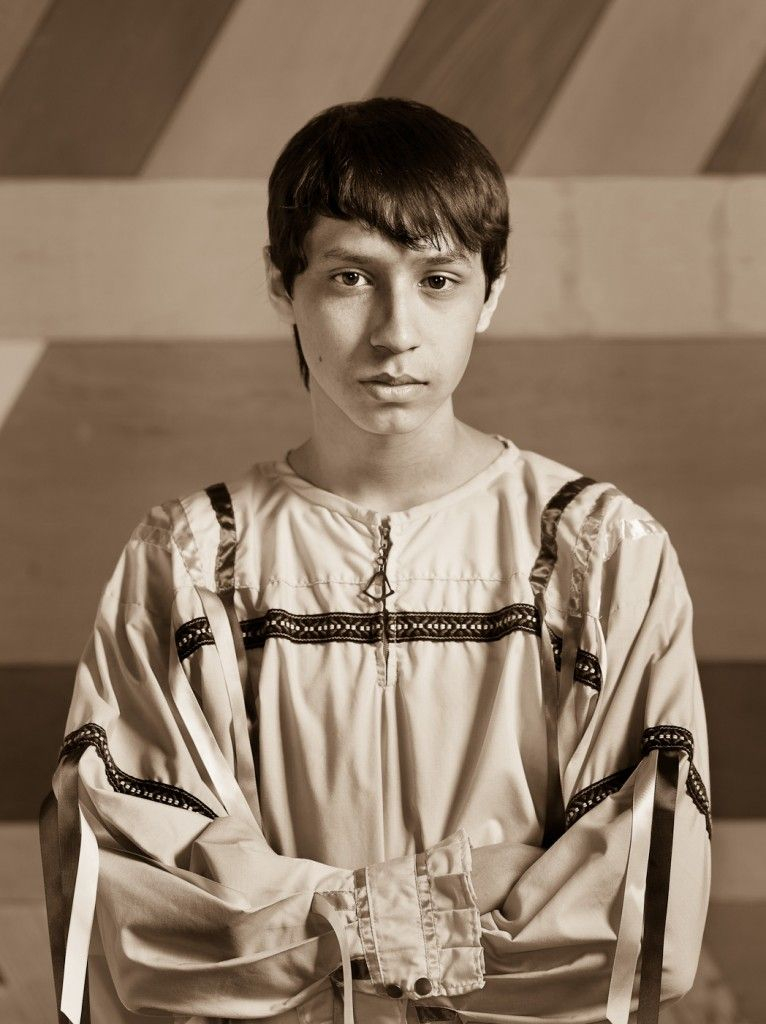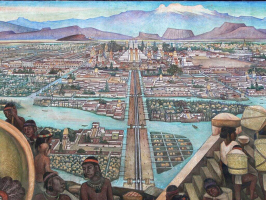Top 6 Nations of the Iroquois Confederacy
Many people refer to the Iroquois Confederacy in upper New York state and southeast Canada as one of the oldest participatory democracies in the world. The ... read more...Great Law of Peace, the confederacy's constitution, is said to have served as a model for the U.S. Constitution, in part because Benjamin Franklin is known to have been very interested in the confederacy's organizational structure and part because the Great Law's emphasis on power balance. The resultant confederacy is made up of six nations: the Mohawk, Oneida, Onondaga, Cayuga, Seneca, and Tuscarora. Its ruling Great Council, which is composed of 50 peace leaders or sachems, still convenes in a longhouse. Read on for more information.
-
The Haudenosaunee, or Iroquois Confederacy, is divided into several parts; the Mohawk being the most eastern. They are a group of Native Americans who speak the Iroquoian language and have villages in southern Canada and upstate New York, mostly along Lake Ontario and the St. Lawrence River. The Kanienkeháka are the Keepers of the Eastern Door, the traditional defenders of the Iroquois Confederation against invaders from the east, and one of the five founding members of the Iroquois League.
The Mohawk people were historically situated west of the Hudson River in the valley of the Mohawk River in modern-day upstate New York. Their territory extended from the St. Lawrence River in the north to southern Quebec and eastern Ontario in the south, larger New Jersey in the east, the Green Mountains in Vermont in the west, and the traditional homeland region of the Iroquoian Oneida Nation in the south.
Kanienkehá:ka people currently reside in villages in southeastern Canada and northern New York State. There are often two chiefs in a Kanienkehá:ka community, and these chiefs are essentially rivals in terms of power. The hereditary chiefs, who are chosen in accordance with Kanienkeháka custom, constitute one category. The majority of the reserves' Kanienkeháka people have created constitutions with elected chiefs and councilors, with whom the Canadian and American governments typically contact only seldom. Following is a list of self-governing communities organized broadly by geographic cluster, along with remarks on the characteristics of community government in each.

Pinterest 
Pinterest -
The Oneida, also known as Onyoteaká ("People of the Standing Stone"), were an Iroquoian-speaking North American Indian tribe that lived in what is now central New York state, U.S., at the time of European contact. They are one of the Iroquois (Haudenosaunee) Confederacy's initial five nations. The Oneida tribe of the Iroquois was semi-sedentary and engaged in grain farming. Families linked via maternal ancestry were housed in longhouses. There were three distinct clans among the Oneida, and each had three delegates in the confederation. A local council served as an advisory body to the chief or chiefs in each village.
The Oneida had only one palisaded town with 60 to 100 longhouses during the 17th century. It was destroyed by a French-Canadian expedition in 1696. The Oneida was the least populous of the Iroquois confederates at the time. After then, the neighborhood was split into Oneida (Upper Castle) and Canawaroghere. Oneida became the sixth nation of the Iroquois Confederacy when a village of North Carolina Tuscarora joined them in the early 18th century; for a generation, war parties targeted their former adversaries living in the Carolinas.
The Iroquois, commanded by the Mohawk leader Joseph Brant, were pro-British throughout the American Revolution, and as a result, the Oneida felt their wrath. Communities of Oneida people sought refuge behind American lines, and Oneida men worked as scouts for the young American troops. The U.S. government paid them back for their losses when they returned home after the war, and they took in the Mohegan nation's remains. Due to disagreements over Quaker missions, traditional religion, and the sale of lands, the Oneida split into factions in the years that followed. Few families remained in Oneida and Onondaga, New York by 1833; those who had not settled in Oneida on the Thames River in Ontario had migrated to Green Bay, Wisconsin.

crazycrow.com 
People's World -
The Onondaga were an Iroquoian-speaking tribe of North American Indians who resided in what is now the U.S. state of New York. They went by the name Onoda'gega, or "People of the Hills". Longhouse towns made of wood and bark were how the Onondaga historically lived. They relocated their homes on a regular basis to sow new fields, look for new fuel, and be closer to wildlife and fish. They raised tobacco, sunflowers, beans, squash, corn (maize), and sunflowers. The village leaders in each community were directed by a council of adult males.
The political and geographic hub of the league was the Onondaga tribe, one of the five founding nations of the Iroquois (Haudenosaunee) Confederacy. The Onondaga provided the chairman and the archivist, who preserved the records of transactions in wampum belts, with their 14 council seats. A substantial portion of Onondaga who supported French interests in the 18th century moved to Jesuit mission communities along the St. Lawrence River. During the dissolution of the Iroquois Confederacy following the American Revolution, a small delegation from another faction—which remained loyal to the British—flew to Grand River in what is now Ontario. But the bulk stayed in the valley of their ancestors. According to early 21st-century demographic estimates, 4,000 people are of Onondaga descent.

Pinterest 
onondaganation.org -
Members of the Iroquois Confederacy who originally lived in the area around Lake Cayuga in what is now central New York state, the Cayuga go by the name Gayogohó:n' ("People of the Great Swamp"). Historically, Cayuga women farmed corn while Cayuga men hunted the region's rich game, waterfowl, and fish (maize). Longhouses with many fireplaces that housed connected families made up villages. Their settlements were located in the areas east of the lake above the marshes south of the Seneca River when they were first seen by the French Jesuit René Ménard in 1656. Around 100 longhouses housed about 1,500 individuals.
The eight exogamous clans were represented on the local Cayuga council, which directed the village heads. The clans were divided into two main moieties, or divisions, which were mostly used for ceremonial purposes like funerals and tournaments. In the past, the Cayuga frequently welcomed new tribes into their villages. They replaced war losses by taking in Huron and Erie captives while residing in a refuge settlement north of Lake Ontario, and in the late 17th century they offered refuge to numerous Siouan- and Algonquian-speaking bands from the nearby south and west. A sizable portion of the Cayuga tribe, which supported the British, migrated to Canada at the start of the American Revolution. The Cayuga Americans who remained in the country after the Revolution sold their New York properties and divided up with other Iroquois tribes in Wisconsin, Ohio, and Ontario. At the start of the twenty-first century, there were over 3,500 Cayuga descendants.

Indianz 
pinterest.com -
The Seneca are the Indigenous Iroquoian-speaking people who formerly resided south of Lake Ontario, one of the five Great Lakes in North America (Seneca: Onödowága:, "Great Hill People"). In the Six Nations or Iroquois League (Haudenosaunee) in New York before the American Revolution, their country was the furthest to the west. With three officially recognized Seneca tribes, the United States is home to more than 10,000 Seneca today. The Tonawanda Seneca Nation and the Seneca Nation of the Seneca, who have two reservations in western New York not far from Buffalo, are the two that are based in New York.
During the Indian Removal, the Seneca-Cayuga Nation's ancestors were moved from Ohio to Oklahoma, where they now reside. In Canada, close to Brantford, Ontario, in the Six Nations of the Grand River First Nation, about 1,000 Seneca people reside. They are Seneca ancestors who moved there after the American Revolution after being forced to abandon most of their lands for their support of the British. The namesakes of the tribe, Seneca the Elder and Seneca the Younger, are illogically connected to one another.
Senecan prose served as a model for essays, sermons, and moralizing in the vernacular literatures of the 16th to 18th centuries in both substance and style. Examples include Jean-Jacques Rousseau, Montaigne, and John Calvin. He was the first of the "Spanish" philosophers, and he always had a significant impact on Spain. He faced criticism for his nineteenth-century expertise from philosophers, physicists, historians, and literary students. However, interest sparked by the 1965 bicentennial celebrations of his death in Spain and later scholarly work signaled the beginning of a Senecan revival in the latter half of the 20th century. The resources of an individual style are used to express and amplify the thoughts of a versatile but unoriginal mind in his 40 books that have survived.

Pinterest 
Pinterest -
The Tuscarora are an Iroquoian-related Native American tribe with current members in New York, USA, and Ontario, Canada (in Tuscarora Skarù:r, "hemp gatherers" or "Shirt-Wearing People"). They came together as a group of people along the Great Lakes, most likely around the same time as the Five Nations of the historic Iroquois Confederacy, who spoke Iroquoian and were located in what is now New York. The Tuscarora traveled south and made their home in what is now known as Eastern Carolina long before European explorers ever set foot on North American soil. They resided along the Roanoke, Neuse, Tar, and Pamlico rivers and were the most populous indigenous people in the region.
The majority of the Tuscarora who survived the 1711–1713 Tuscarora War against English colonists and their Indian allies departed North Carolina and moved north over a 90-year span to Pennsylvania and New York. Due to their same language and cultural ancestry, they joined forces with the Iroquois in New York. They were recognized as the Sixth Nation of the Iroquois Confederacy, or Haudenosaunee, in 1722 after being encouraged by the Oneida. The Tuscarora once shared reservation property with the Oneida after the American Revolution, when they and the Oneida sided with the colonists, until eventually acquiring their own. Federal recognition is granted to the Tuscarora Nation of New York.
The Tuscarora in New York no longer regarded individuals who remained in North Carolina as tribe members when the migration was finished in the early 18th century. Some North Carolina residents of Tuscarora heritage have created bands that they identify with since the late 20th century. As of 2010, a number of Robeson County bands have temporarily banded together under the name Tuscarora Nation One Fire Council.

blogspot.com 
Niagara Gazette



























